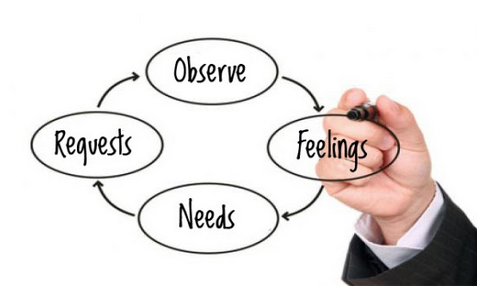"The best way I can get understanding from another person is to give this person the understanding, too. If I want them to hear my needs and feelings, I first need to empathize."- M. Rosenberg.
It does not take a lot to trigger a nasty comment or to start a conflict. It could be something simple as being a little behind in your work or having to deal with an arrogant client. It is hard to handle your relationship with others while managing your mood.
Good communication is essential to handle these sorts of conflicts in both your professional & private lives. Unfortunately, most people do not know what violent communication is. They think it is violent only when it involves fists. So, they end up unconsciously using violent communication. They do not intentionally judge or demean others. But the way they express themselves leads to conflicts. Adopting non-violent communication lets you make the environment around you both productive and pleasant.
What is non-violent communication?
The expression 'non-violent' comes from Gandhi's non-violent movement against British rule in India. It refers to communicating with others without emotional or physical harm. Clinical psychologist Marshall B. Rosenberg developed non-violent communication (or NVC) based on the concepts used in person-centered therapy.

Marshall B. Rosenberg used two animals to demonstrate the two types of communication, jackal, and giraffe.
- The jackal, the carnivorous, represents violent communication that is deemed aggressive. Same as in domination, it uses violence and manipulation techniques such as guilt, shame, punishment, and praise to communicate.
- The giraffe is herbivorous and represents non-violent communication. The giraffe has very few enemies in the wild. Its long neck symbolizes a clear-sighted speaker who is aware of his fellow speakers' reactions. The giraffe has the largest heart among land animals, which represents the compassionate side of non-violent communication.
Watch the video for a detailed explanation of the jackal and the giraffe theory.
Non-violent communication is a mainly verbal method of communication-based on two assumptions.
- We are all compassionate human beings with the same basic needs.
- We use behaviors such as shame, judgment, and blame when we are unable to fulfill our needs.
The 4 components of NVC

You should follow these four steps when you are communicating with your colleagues to implement non-violent communication:
- Observations: Observe what others are doing without judgment. Do not try to interpret or analyze those actions.
- Feelings and attitudes: Express how you feel about the situation/action.
- Needs: Identify and explain the requirements connected to those feelings.
- Requests: Make a clear request that might help your colleague attend to those needs.
Two modes of NVC application
The NVC framework involves listening empathetically and expressing honestly. Each of these modes uses the components, observation, feeling, need & request.
Empathic Listening
Empathic listening consists of listening and responding to another person. It is also known as active listening or reflective listening. It improves trust and mutual understanding between all parties.
In empathic listening, you have to listen patiently to what the other person has to say. You don't have to agree with it. But it would be best if you showed that you accept their view though. Try to sense what the other person is experiencing and focus on emotional content, the literal meaning of the words, and their body language. Reflect on the other person's feelings and thoughts. Make sure you respect their trust and confidence once you successfully win it.
During empathy listening, you can apply the four components and make an empathy guess like this:
When you see (hear, remember, etc.) ______(observation) are you feeling ______ because you are needing ______? Would you like ______ (request)?
Examples
- Observation - When you see me coming to work late
- Feeling - Are you feeling worried
- Need - Because you need to know whether I can finish my work on time?
- Request - Would you like me to come a little early?
Find some empathy listening examples here.
Expressing honestly
Expressing honestly is also known as "speaking from the heart." You are not supposed to be aggressive. You should present the facts (your observation) clearly while explaining your feelings and the need it initiates. Make a request that clearly shows what sort of response you are expecting.
During expressing honestly, you can apply the four components like this:
When I see (hear, remember, etc.) ______(observation) I am feeling ______ because I need ______? Would you be willing to______ (request)?
Examples
- Observation - When I see you coming to work late
- Feeling - I feeling worried
- Need - Because I need to know whether you can finish your work on time?
- Request - Would you be willing to come early or let us know when you’re getting late?
Watch the video for a better understanding.
The advantages of NVC
Non-violent communication entails a number of advantages:
- Non-judgmental communication
- Builds trust and respect
- You learn to identify and understand your own needs as well as others
- You learn how to express your needs
- Reduces tension
- The person in question does not feel defensive or cornered
- Explaining your expectations clearly reduces misunderstandings
- CNV encourages others to cooperate,
- Creates a safe environment to resolve conflicts calmly and efficiently.
Conclusion
People use NVC worldwide to assist people in developing self-compassion and create deeper connections in their relationships. Compassionate communication helps us recognize and value everyone's feelings and needs as it makes us connect with ourselves and others honestly and meaningfully.
Just like you can catch more flies with honey than with vinegar, a kind request has a better chance at success than an aggressive, authoritative demand.
Non-violent communication will not come naturally to you. You need to change your habits and practice what you learned. Soon, it will come naturally to you. By practicing Non-violent communication at your workplace, managers and employees can improve their communication skills to resolve conflicts and improve their working environment. People learn to understand, what they observe, what they feel, and what they want to ask themselves and others. They will feel the pleasure of improving each other's well-being and above all start working to create a psychologically safe environment to foster self-organizing teams.
Lance Dacy is a Certified Scrum Trainer® who’s passionate about applying Scrum beyond technology to all areas of business and life. If you’d like more education or certifications related to this topic, check out the upcoming class schedule.